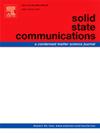Influence of Sb doping on electrical and magnetic properties of SnO2 compounds
IF 2.1
4区 物理与天体物理
Q3 PHYSICS, CONDENSED MATTER
引用次数: 0
Abstract
Extensive research has been conducted to explore the potential applications of oxide materials doped with non–magnetic elements for spintronic devices. Our current investigation focuses on the synthesis of Sn1-xSbxO2 (where x ranges from 0 to 0.10 with a step size of 0.02) polycrystalline samples via the traditional solid–state reaction method, along with an analysis of their current–voltage (I–V) characteristics, high–temperature resistivity, and room temperature magnetic hysteresis (B–H) curves. By employing an electrometer, the I–V characteristics were recorded and it indicate that the incorporation of Sb doping enhances the conductivity of SnO2, resulting in a lower voltage for leakage current saturation. The high temperature electrical resistivity measurements of these compounds revealed that an increase of Sb doping concentrations led to the reduction of the resistivity. The B–H loop study displays ferromagnetic behaviour along-with coercivity value increasing from 540 Oe to 620 Oe upon increasing Sb doping concentrations.
Sb掺杂对SnO2化合物电磁性能的影响
人们对掺杂非磁性元素的氧化物材料在自旋电子器件中的潜在应用进行了广泛的研究。我们目前的研究重点是通过传统的固相反应方法合成Sn1-xSbxO2(其中x范围为0 ~ 0.10,步长为0.02)多晶样品,并分析其电流-电压(I-V)特性,高温电阻率和室温磁滞(B-H)曲线。利用静电计记录了SnO2的I-V特性,结果表明Sb掺杂提高了SnO2的电导率,降低了泄漏电流饱和的电压。这些化合物的高温电阻率测量表明,锑掺杂浓度的增加导致电阻率的降低。随着Sb掺杂浓度的增加,B-H环表现出铁磁行为,矫顽力值从540 Oe增加到620 Oe。
本文章由计算机程序翻译,如有差异,请以英文原文为准。
求助全文
约1分钟内获得全文
求助全文
来源期刊

Solid State Communications
物理-物理:凝聚态物理
CiteScore
3.40
自引率
4.80%
发文量
287
审稿时长
51 days
期刊介绍:
Solid State Communications is an international medium for the publication of short communications and original research articles on significant developments in condensed matter science, giving scientists immediate access to important, recently completed work. The journal publishes original experimental and theoretical research on the physical and chemical properties of solids and other condensed systems and also on their preparation. The submission of manuscripts reporting research on the basic physics of materials science and devices, as well as of state-of-the-art microstructures and nanostructures, is encouraged.
A coherent quantitative treatment emphasizing new physics is expected rather than a simple accumulation of experimental data. Consistent with these aims, the short communications should be kept concise and short, usually not longer than six printed pages. The number of figures and tables should also be kept to a minimum. Solid State Communications now also welcomes original research articles without length restrictions.
The Fast-Track section of Solid State Communications is the venue for very rapid publication of short communications on significant developments in condensed matter science. The goal is to offer the broad condensed matter community quick and immediate access to publish recently completed papers in research areas that are rapidly evolving and in which there are developments with great potential impact.
 求助内容:
求助内容: 应助结果提醒方式:
应助结果提醒方式:


